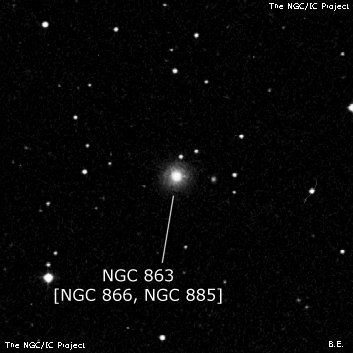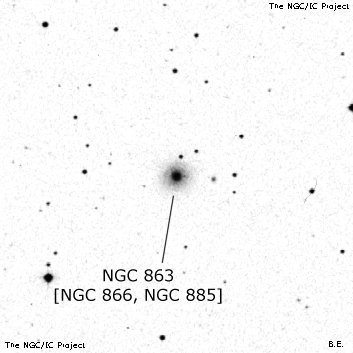NGC/IC Project Restoration Effort
(This is a very very beta version)
NGC863


Basic Information
Location and Magnitude
Right Ascension: 2:14:33.5
Declination: -0:45:58
Constellation: CET
Visual Magnitude: 12.9
Historic Information
Discoverer: Herschel W.
Year of discovery: 1785
Discovery aperture: 18.7
Observational
Summary description: vF, R, bM, stellar
Sub-type: Sa
Corwin's Notes
=====
NGC 863 = NGC 866 = NGC 885 and company.
The problem here is what to do with the five observations reported by Lewis
Swift in his fifth "catalogue" of nebulae, published in Astronomische
Nachrichten No. 2763 (Vol. 116, page 33, 1886). All five received NGC
numbers: 856, 859, 866, 868, and 885. So, in addition to NGC 863, found by
William Herschel (H III 260), there are six numbers in the area and but only
three fairly bright galaxies.
NGC 863 itself is no problem. The NGC position, from JH's observations, is
very good (there is a 30 second error in WH's RA; see Dreyer's note in his
edition of WH's Scientific Papers). It obviously pins down the brightest of
the galaxies in the area (which, by the way, is Markarian 590). Another of
the galaxies is very nearly as bright (Mark 590 and this second galaxy are
listed at m_p = 14.0 and 14.4, respectively, in the CGCG), and I'm a bit
surprised that the Herschels did not see it.
These two are obviously the two brightest that Swift found on the night of 3
October 1886 (N859 and N866, numbers 23 and 24, respectively, in his AN list).
The relative positions that he gives them are correct -- "np of 2" and "sf
of 2." The declinations are not too bad, but the RA's are out. The third
object that he found that night is NGC 868; the position is not too bad, and
the description (what there is of it: "eF, pS, R") is appropriate.
Swift returned to the area on 31 October of the same year, finding two more
objects. The first of these, NGC 856 (the 22nd object in Swift's list), has a
good position, and the description ("eF, S, lE, F * close") is again
appropriate. The star was measured by both Bigourdan and Howe, and is about a
minute of arc east and slightly north of the galaxy. The second object,
NGC 885 (number 27), has -- if my conjecture is correct -- the largest
positional error of any of Swift's five objects here: five minutes of time in
RA. Swift's declination is good.
What I believe happened on this night is that Swift simply rediscovered the
two brightest galaxies. So, NGC 859 = NGC 856 and NGC 885 = NGC 863. His
descriptions of the brightnesses of the two objects, though, is systematically
fainter -- "eF" vs. "pF" for the fainter of the two, and "vF" vs. "pF"
for the brighter -- than on his earlier night's observations. This suggests
to me that the sky was not as good on this second night as on the first, or
that Swift was then simply noting nebulae as fainter.
The right ascension problem for NGC 885 is, I believe, one of Swift's large
random errors that are littered throughout his lists. For example, in the
same list, NGC 1689 (found 22 October 1886) is also five minutes out, being =
NGC 1667. Another example: NGC 1037, also in the same list, has as a part of
its description "[GC] 581 in field." This means that GC 581 = NGC 1032 must
be within 16 arcminutes of Swift's object (Swift was using an eyepiece that
had a field diameter of 33 arcmin), but his declination for NGC 1037 is 2 deg
49.7 arcmin different from NGC 1032's declination!
In summary, then, I think that my original assignments of the NGC numbers are
probably correct, though we do not have the evidence to be absolutely sure.
The observations reported by Herbert Howe in M.N. 68, 356, 1898, and 69, 29,
1900, support my position: he could not find NGC 859, NGC 866, and NGC 885,
though he reports observing NGC 856, NGC 863, and NGC 868. Bigourdan also has
observations of only three objects here, though he assigns a different number
to the faintest: NGC 859 rather than NGC 868. I've yet to sort out his data
completely, however.
Steve's Notes
=====
NGC 863
17.5" (12/4/93): fairly faint, very small, round, fairly concentrated, very small bright core, stellar nucleus. NGC 856 is 14' WNW and NGC 868 21' ENE.



